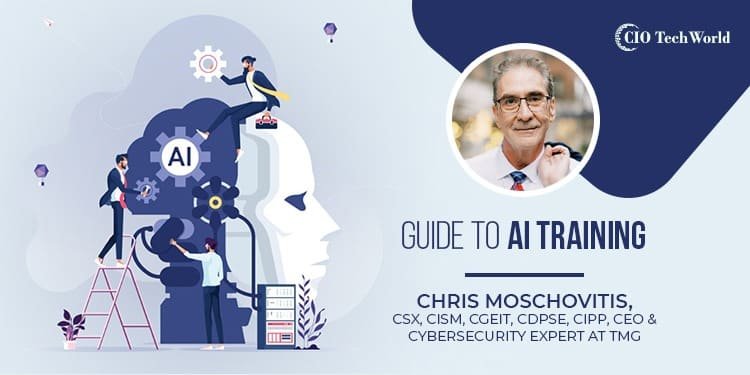A significant challenge facing business leaders today is the growing skills gap between those who have access to AI training and those who do not. The so-called AI revolution will ultimately impact workers across all industries and at all levels, but AI training programs are often limited to white-collar, “high-potential” employees. Business leaders must take proactive steps to eliminate this disparity, by providing equitable access to AI training for all employees, regardless of their role or educational background.
But let’s be clear: AI training for employees is not some mere “do-gooder” act of social responsibility. Investing in AI training is a strategic business decision. If well-leveraged, AI tech can unlock significant improvements in efficiency, productivity, and customer satisfaction. The potential applications of AI are vast and varied, and businesses that fail to capitalize on these opportunities risk being left behind.
But what does AI training look like? And how can you train employees to manage a technology that changes so rapidly?
Learning to Learn
Technology blogs are overflowing with tips about “the latest AI hack to supercharge your business” and so on. But the truth is, any supposedly exciting “AI hack” may be outdated by the time you hear about it.
People used to say that “internet years” were akin to “dog years,” with one year on the internet equaling about seven in the “real world”. Given what we’ve seen since ChatGPT debuted in November 2022–and yes, you read that right, ChatGPT is not quite two years old–“AI years” are going to move even faster.
Consequently, the primary goal in so-called reskilling (or upskilling) for AI is less about learning any particular type of software and more about learning how to learn. Steve West, the head of global talent acquisition at Verizon, told The HR Digest that “the ability to learn and embrace new ways of thinking” is more important than any particular programming skill.
The AI revolution is not just about letting “robots” do our jobs for us. It is about augmenting human capabilities and creating new opportunities for growth and innovation. A McKinsey Global Institute report estimated that by 2030, as much as 30 percent of the hours currently worked could be automated. And given how quickly generative AI tools are improving, one can be forgiven for wondering if 30 percent is too conservative an estimate. The key to success lies in preparing employees to work alongside AI rather than being replaced by it.
Where Do I Begin AI Training?
To effectively implement AI training for employees, leaders must take a comprehensive and strategic approach. Here are some key steps to consider:
1. Assess current AI skills and needs
Begin by assessing your organization’s current AI capabilities and identifying the specific skills and knowledge gaps that need to be addressed. This may involve conducting surveys, interviews, or assessments to determine the current level of AI literacy among your employees and the specific areas where upskilling is needed.
2. Define AI learning objectives and outcomes
Based on the skills assessment, define clear learning objectives and outcomes for your AI training program. These should be aligned with your organization’s overall business strategy and goals, and should be specific, measurable, achievable, relevant, and time-bound (SMART).
3. Develop a comprehensive AI training curriculum
Create a comprehensive curriculum that covers the key areas of AI relevant to your organization, such as machine learning, natural language processing, computer vision, and data analytics. The curriculum should be tailored to the specific needs and skill levels of your employees, and should include a mix of theoretical knowledge and practical, hands-on learning opportunities.
4. Identify the right training partners and platforms
Consider partnering with external training providers, such as universities, online learning platforms, or AI consultancies, to develop and deliver your AI training program. Look for partners with a proven track record of success in AI education and a deep understanding of the latest industry trends and best practices.
5. Implement a continuous learning approach
Begin by piloting your AI training program with a small group of employees and gathering feedback to refine and improve the curriculum. Then, roll out the program more broadly across the organization, using a phased approach to ensure that all employees have the opportunity to participate. Emphasize the importance of continuous learning and provide ongoing opportunities for employees to apply their new skills and knowledge on the job.
6. Evaluate the impact of your AI training program
Regularly measure and evaluate the impact of your AI training program using a range of metrics, such as employee engagement, skills acquisition, job performance, and business outcomes. Use this data to continuously improve and optimize your program over time.
7. Foster a culture of AI innovation
Finally, work to foster a culture of AI innovation and experimentation across your organization. Encourage employees to apply their new skills and knowledge to real-world problems and projects, and create opportunities for cross-functional collaboration and knowledge sharing.
But Why Should I Learn This?!
Some employees may be resistant to learning about AI, either because they fear it will replace them or because they lack confidence in their ability to learn new skills. Addressing these concerns and creating a culture of continuous learning is crucial. Here are some strategies that can help:
1. Communicate the benefits clearly
It’s essential to communicate the benefits of AI training programs to employees. Emphasize how these programs can help them develop new skills, advance their careers, and make their jobs easier and more efficient. Highlight real-world examples of how AI is being used in your industry and how it can help your organization stay competitive.
2. Address concerns about job security
Many employees may resist AI training because they fear that it will mean the end of their jobs. It’s important to address these concerns head-on and emphasize that the goal of AI training is to augment and enhance human capabilities, not replace them. Provide examples of how AI can help employees work more efficiently and effectively, freeing up time for higher-level tasks and creative problem-solving.
3. Provide incentives and recognition
Offering incentives and recognition for employees who participate in AI training programs can help to overcome resistance and increase engagement. This may involve bonuses, promotions, or other rewards for employees who complete training and apply their new skills on the job. Publicly recognizing and celebrating employees who have successfully completed training can also help to create a positive culture around learning and development.
4. Make training accessible and flexible
Ensuring that AI training programs are accessible and flexible can help to overcome resistance from employees who may have limited time or competing priorities. Offer a range of training options, including online courses, in-person workshops, and self-paced learning modules. Consider providing time during work hours for employees to complete training, or offering flexible scheduling options to accommodate different learning styles and preferences.
5. Provide ongoing support and resources
Just as AI is continually evolving, so must your up-skilling efforts. Providing ongoing support and resources can help to overcome resistance and ensure that employees are able to apply their new skills effectively on the job. This may involve offering coaching and mentoring, creating communities of practice where employees can share knowledge and best practices, and providing access to tools and resources that support ongoing learning and development.
6. Lead by example
Finally, it’s important for leaders at all levels of the organization to demonstrate their own commitment to learning and development. When employees see their managers and executives actively participating in AI training programs and applying new skills, it can help to create a culture of continuous learning and innovation.
By implementing these strategies, organizations can help to overcome employee resistance to AI training programs and create a culture of continuous learning and development that will be essential for success.
Tips on Best Practices
What makes retraining programs effective? Here are some suggestions on how to get the most “bang” for your buck when it comes to up-skilling.
- Tailor programs to specific roles and skill levels: Successful AI training programs are often tailored to the specific needs of different roles and skill levels within the organization. This may involve offering a range of courses and learning paths that cater to varying levels of technical expertise and job responsibilities.
- Provide hands-on, project-based learning: Many successful AI training programs emphasize hands-on, project-based learning opportunities that allow employees to apply their knowledge to real-world problems. This helps to make the learning more engaging and relevant to their day-to-day work.
- Focus on truly important skills: Businesses should focus on developing two important human skills in their employees: effective interpersonal skills and domain knowledge. Interpersonal skills, such as effective communication and teamwork, are crucial for collaborating with AI systems and other team members. Domain knowledge helps employees make informed decisions when working with AI tools
- Foster a culture of continuous learning: Creating a culture of continuous learning is essential for the success of any AI training initiative. This may involve offering incentives for employees to participate in training, recognizing and rewarding those who develop new skills, and providing opportunities for ongoing learning and development.
- Partner with external experts and institutions: Many companies have found success by partnering with outsiders, such as universities and research organizations, to develop and deliver AI training programs. This can help to ensure that the training is of high quality and aligned with the latest industry standards and best practices.
- Collect feedback: Regularly collecting feedback from employees and measuring the impact of training programs is essential for continuous improvement. This may involve conducting surveys, analyzing training completion rates and job performance metrics, and iterating on the programs based on the insights gathered.
By keeping these challenges and best practices in mind, companies can design and implement effective AI training programs that help their employees develop the skills and knowledge needed to thrive in an AI-powered future.
Real-World AI Education, Part One: The Tech Giants
You may be wondering what reskilling programs look like in practice. Here are just a few examples of major companies that are investing in AI training programs to upskill their workforce and stay competitive.
Amazon
Amazon has launched several initiatives to upskill its workforce in AI, including the Amazon Technical Academy and the Machine Learning University. These programs offer employees the opportunity to learn about AI and machine learning through a combination of online courses, workshops, and hands-on projects. The goal is to equip employees with the skills they need to develop and deploy AI solutions across the company’s various business units.
Google has a long-standing commitment to AI education and offers a range of training programs for its employees. One notable example is the Google AI Residency Program, which is a 12-month research training program designed to help individuals with a passion for AI to become leaders in the field. The program includes mentorship from Google researchers, hands-on projects, and opportunities to publish research papers.
Accenture
Accenture has launched an AI training program called “AI Accelerator” to upskill its workforce in AI and machine learning. The program includes online courses, workshops, and real-world projects that help employees develop practical skills in areas such as data analytics, natural language processing, and computer vision. Accenture has also partnered with leading universities to offer advanced AI training to select employees.
Microsoft
Microsoft has launched several initiatives to promote AI literacy and skills development among its employees. One example is the Microsoft Professional Program for AI, which is a series of online courses that cover topics such as machine learning, deep learning, and natural language processing. The program is designed to be accessible to employees with varying levels of technical expertise and includes hands-on labs and real-world projects.
By providing comprehensive and accessible training opportunities, these companies are empowering their employees to work alongside AI and drive innovation across their organizations.
Real World AI Education, Part Two: The Rest of Us
But if your organization lacks the resources to create an internal “AI academy,” don’t panic. There are a growing number of firms ready to step in with their own, custom-built AI curricula. These programs try to ensure that all employees have the opportunity to develop the skills they need to thrive in an AI-powered future.
Another best practice is to bring in IT consultants such as my firm, TMG. Implementing an AI training program can be a significant change for many organizations, and employees may be resistant or uncertain about the impact on their roles and responsibilities. IT consulting firms can provide change management and communication support to help organizations navigate these challenges and build buy-in and engagement among employees. They can help organizations assess their current AI capabilities and identify specific skills gaps that need to be addressed. IT consulting firms with expertise in AI and machine learning can help organizations develop comprehensive AI training curricula that are tailored to their specific needs and goals.
Significantly, IT consulting firms can help organizations identify and implement the right technology solutions and platforms to support their AI training efforts. This may include learning management systems, AI development tools, and data analytics platforms. Finally, IT consulting firms can help organizations align their AI training efforts with their overall business strategy and goals. They can provide guidance on how to prioritize training investments, measure the impact of AI on business outcomes, and create a culture of AI innovation and experimentation.
By following these steps and taking a strategic, comprehensive approach to AI reskilling, organizations can help their employees develop the skills and knowledge needed to thrive in an AI-powered future, while also driving business value and competitive advantage. The time to build the skills needed for an AI-powered future is now. Only those who act quickly and strategically will be well-positioned to reap the benefits of this transformative technology.
Read more articles by Chris Moschovitis:
Unmasking Algorithmic Bias: Hidden Injustices within AI
AI Governance: A Practical Guide for Business Leaders

I am certified in Cybersecurity (CSX, CISM), Enterprise IT Governance (CGEIT), Data Privacy Solutions Engineering (CDPSE), and as a Certified Information Privacy Professional (CIPP/US). I am also an active member of organizations including ISACA, IAPP, and ISSA. In 2018, my book Cybersecurity Program Development for Business: The Essential Planning Guide was published by Wiley to critical acclaim. My second book, Privacy, Regulations, and Cybersecurity: The Essential Planning Guide, received an equally positive reception upon its release by Wiley in 2021. Additionally, I co-authored History of the Internet: 1843 to the Present and contributed to the Encyclopedia of Computers and Computer History as well as the Encyclopedia of New Media.








